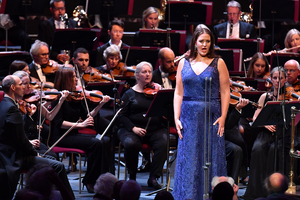Review: PROM 31: BRAHMS, BRUCKNER & STRAUSS, Royal Albert Hall

![]() The epithet "Romantic" - the subheading of Bruckner's "Symphony No. 4", among an opulent bevy of others - once symbolised a type of behaviour derisible to modern eyes.
The epithet "Romantic" - the subheading of Bruckner's "Symphony No. 4", among an opulent bevy of others - once symbolised a type of behaviour derisible to modern eyes.
Novels of the 19th century almost competed in outlandishness: drowning oneself for love was honourable for both the hero and the heroine; fainting from dolour was routine (a couch was even named for it); and fictional personae never dreaded death as much as boredom.
Perhaps this is the reason why an ever-so-brief epoch was abound in rich, immersive melodies whose rising waves were inexhaustible and loath to crest. Such was the highlight of Prom 31 - the above-mentioned Bruckner's Symphony No. 4 - and such was the interpretation of these works in the late 19th century and beyond, including last night.
Beginning the evening of extravagant works with Brahms' Variations on the St Anthony Chorale, conductor Esa-Pekka Salonen assumed the baton of the Philharmonia Orchestra with a well-regulated and yet somewhat tempered set of rhythms.
Salonen's measured, Classical interpretation preferred to honour the work's former title "Variations on a Theme by Haydn": a name taken from the misattribution of the original work from which Brahms composed variations. Though it has since been established that the author of the source piece was likely one of Haydn's students, Salonen's tempi leaned perhaps more closely to its late-18th-century manner than Brahms' novel changes.
While this meant that the strings were often carefully on point, the reading would have been a better understandable stylistic feat if certain instrumental errors hadn't been apparent: too often brass notes slipped out of the instruments' commanding group, still dangling at a phrase's tail-end; the cohesion of woodwind was sour and certain attacks of brusque, separate chords along several sections became out-of-sync.
Soprano Lise Davidsen's performance of Richard Strauss's "Four Songs" - a work frequently sidelined in favour of "Four Last Songs" - showcased a cavernous, at times seemingly omnipotent voice. Though her interpretation provided ample evidence of an ability to stretch the instrument into forceful crescendo as much as to shrink it in sorrowful diminuendo, at times these two extremes would seesaw back and forth too evidently.
Breath control was nonetheless sumptuous in long loops of phrases. It is precisely for this reason that Davidsen, a now-experienced performer, doesn't need to exaggerate her volume one way or another simply to prove her undoubted abilities.
In the second song "Cäcile" - an effervescent, somewhat sensual avowal of love - efforts to raise volume or, in some instances, sustain breath control in more complex lines - hampered a much-needed liberty of vocal expression. While there was definitely ardour in Davidsen's rendition, abrupt changes in either dynamics or, less often, pace demonstrated a desire to perform rather than honour the sentiments of the song's lovestruck character. Her confidence was better gauged in an encore of "Dich, teure Halle" from Wagner's Tannhäuser: the aria's unabashed, dramatic nature flaunted her capacities.
The last song "Morgen" featured a well-attenuated, long-drawn-out diminuendo on the word "schauen" at the end of a phrase, meaning "[tomorrow], speechless we shall gaze into each other's eyes." It is obvious the artist in the singer is a living creature; Davidsen simply needs to unchain her from the fetters of nerves, or perhaps a desire to prove.
Salonen's conducting of the 1894 "Four Songs" embraced their Romantic extravagance whilst simultaneously finding the subtler, underlining motifs - often on woodwind or slender string tremolos - that would percolate early 20th-century music. Rhythms selected for the songs altered diversely; unfortunately, so did instrumental coherence. Some of the time percussion was astray in its timing; brass and strings struggled to cleanly fuse towards the end of "Ruhe, meine Seele", and occasional orchestral endings of phrases came off not at once.
Embarking on the 68-minute Bruckner Symphony No. 4, Salonen led the work with a furious array of abrupt, caustic attacks; it swept down from great heights of volume to the pit of staid quiet with turbulence.
Just as the cornucopia of the first movement's motley oscillations were beginning to feel palpable, Salonen stopped the orchestra abruptly for a rowdy, likely inebriated patron shouting in the gods. By the time the conductor had made this decision the audience member had been escorted out of the hall; it was quiet. Snapping the music's gradually evolving ambience proved a more dangerous disturbance than the ill-behaved listener; Salonen then started the first movement all over again. It was eerie to witness the "show must go on" motto disregarded. In September 2011, conductor Zubin Mehta and the Israel Philharmonic persevered during a Prom amidst dozens of heckling political protesters.
Painting the symphony's melodic and textual differences with mostly broad colouring, Salonen captured the contrast between furore in the first movement and solemn resignation in the second "Andante, quasi allegretto". The outline of this symphony was caught, but individual sections were rough-hewn: brass intending to conjoin overlapped; certain staccato passages, despite being labelled "andante", were maybe excessively so.
By the Finale of the fourth movement, zealous woodwind were in need of harnessing. The performance was fierce and unbridled, accentuating pain throughout the work as much as joyfulness.
However, as is the case with many fictional heroes throughout the novels of Goethe and other Romantic contemporaries, the conductor surrendered to passion at the expense of the ensemble's undoing.
At times, it was almost a quaint listening experience: many conductors of the long and distant - not to mention recent - past have offered a somewhat delectable, semi-polished outline of renowned works. Encountering Symphony No. 4 through this filter presented no danger to curious first-time listeners. Yet overall the night's at times old-fashioned takes on pieces missed out on those striking subtleties that leave a stamp.
Photo credit: BBC/Chris Christodoulou
Videos

